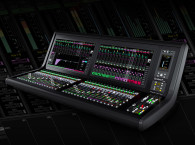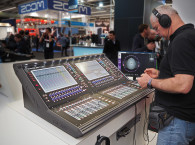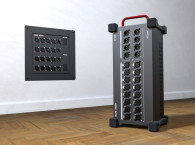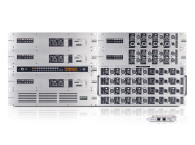
With this new V3 software release, Solid State Logic introduces more than 40 new software and hardware features and updates for its SSL Live console range, significantly improving the balance between power, features and price for each model in the series.
The L500 becomes the L500 Plus to mark the significance of this new release in the ongoing evolution of the acclaimed live sound console. The power of the L500 rises from 192 mix paths to 256 with a doubling of Effects processing power (depending on the effects selected). The L300 also enjoys a power increase from 128 to 192 mix paths.

The Version 3 software release provides an extensive and impressive collection of feature additions to SSL Live consoles, including a superb new Super-Q feature, an optional Dante interface card, remote control software, a console expander mode, user interface changes, new effects, enhancements to the Solo system, and a collection of features designed for customers who broadcast their productions.
Super-Q is the next generation of Live’s Query function, offering unprecedented workflow flexibility from the touch of a single button. Just like the original Query function, Super-Q allows the user to ‘spill out’ the contributing elements or destinations for a selected fader/path across the control surface. Pressing a channel’s “Q” button shows the mix buses to which the channel is routed. Querying a mix bus will show only the channels that are contributing to that mix. Pressing a VCA’s Q button will show all channels under its Control.
Super-Q also shows the send levels to and from mixes, enabling instant and accurate mix control, either from a channel- or mix-centric view. These contributions can be displayed either on the rotary encoders at the top of each fader strip or automatically ‘flipped’ onto the faders. This can work in either direction; Query an input channel to gain access to its send levels to all mixes, or Query a mix bus to access the send levels from each channel contributing to it.
Super-Q has two modes; ‘Compressed’ mode shows a focussed view of only the audio paths contributing to or from the Queried path. ‘Expanded’ mode offers user-defined layers and banks, allowing the user to lay out exactly where they want each channel to appear on the surface. The modes are configurable on a per-path type basis, giving the user complete control of their workflow.
These new features operate in conjunction with the console’s Follow modes that allow any combination of Select, Solo and Query buttons to be linked. This allows, for example, an auxiliary to be selected to the main screen, Soloed for monitoring and Queried to access its mix sends on faders for only the channels contributing to it, all from the press of a single button. This hugely flexible feature makes SSL Live consoles especially well-suited to monitor mixing.
SSL’s SOLSA (SSL Offline Setup Application) software allows creation and editing of Live console Showfiles on a laptop, desktop or tablet PC. Almost anything that can be done on a console can be manipulated and configured using SOLSA. This includes console architecture configuration and setup of Fader Tile Layers and Banks. Stageboxes and I/O routing can also be assigned along with the creation of scenes and other automation editing. SOLSA also allows adding effects, manipulate channel processing settings, bus routing and VCA assignments. SOLSA includes the same inline Help System as the Live console software, offering a built in user guide with tutorials and reference sections.
The SOLSA PC application can be connected to a console using a wired or wireless connection for real time control of the console from a laptop or tablet PC. SOLSA can also be used “offline” when access to a console is not possible for preparation of show files.

A new Dante card option offers up to 32 × 32 channels of I/O at 96 kHz over a redundant Dante connection. The card can be set to operate at 48 kHz or 9 6kHz, independently of the rest of the console. The card expands the maximum inputs and outputs for SSL Live consoles from 568 to 600 for an L300 and from 976 to 1008 for an L500 Plus.
For those situations requiring integration with existing Broadcast infrastructures and/or features that are suited to established broadcast audio workflows, SSL V3 software now includes a 48-kHz mode to facilitate integration. New 5.1 and 4.0 audio path formats have also been introduced with all of the necessary routing and monitoring required to support them. The Pan system now includes SSL’s Surround Panner and a selection of the Insert Effects now have 4.0 and 5.1 specific versions.
Multichannel Fold-down options have been added with settings available to control the steering logic when routing 5.1 or 4.0 formatted paths onto mono, stereo and LCR buses. Solo Dim mode has been added to the newly enhanced Solo system, which now also includes six external solo sources.
Where two operators wish to control the same audio environment or when more physical faders are required, a second console may be connected to the main console. This expands the control surface available and allows multiple surfaces to share the processing and I/O power of the main console. The active automation scene is automatically synchronized between the two control surfaces for simultaneous but independent control.
The V3 release also contains a significant collection of individual additions and improvements to the consoles User Interface and Processing Tools. Some highlights include; VCA Control of Matrix Channels, new implementations for the User Assignable Buttons, a superb new stereo version of the Fixed Point Per Octave Analyzer called the FPPO-lyzer which includes a difference mode, allowing the difference between two signals to be monitored and two sets of crosshairs to track the maximum level/frequency and the level of a specific frequency. BPM & Note based editing has been added to Delay Modules… and stereo channels now have a Balance and Mono Sum Controls.
SSL Live V3 is due for public release in May 2015 and will become standard on all new consoles. Upgrades will be available to bring existing consoles to V3 specification.
 New SSL CTO
New SSL CTOWith this evolution of its live sound products, its not surprising to hear that Dr. Enrique Perez Gonzalez has been appointed Chief Technology Officer for Solid State Logic’s Board of Directors. Dr. Perez has been promoted from his current role as Head of R&D and became a board member effective April 1.
“Enrique is one of those rare individuals who has deep technical ability, first-hand experience of our markets and the skills to manage product research and development effectively,” states SSL’s CEO Antony David. “Even more importantly, he has the vision to build upon our technical heritage and the resources to take us forward.”
Dr. Perez joined SSL in 2011, spearheading the development of the Tempest processing platform and SSL’s new Live console. An electronics and communications graduate from ITSEM, Mexico, which included a year at Australia’s Royal Melbourne Institute of Technology, he is an alumnus of the University of York (UK), and holds a doctorate in electronic engineering from the Queen Mary University of London.
www.solidstatelogic.com






